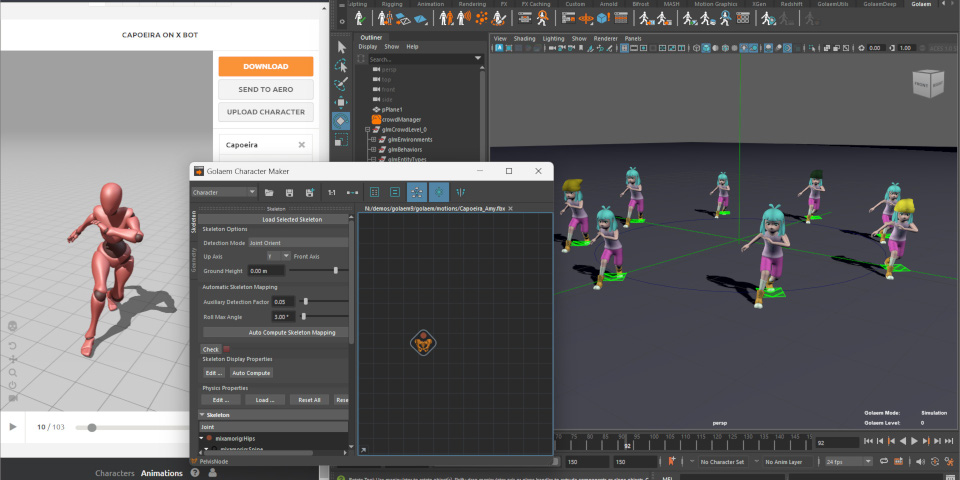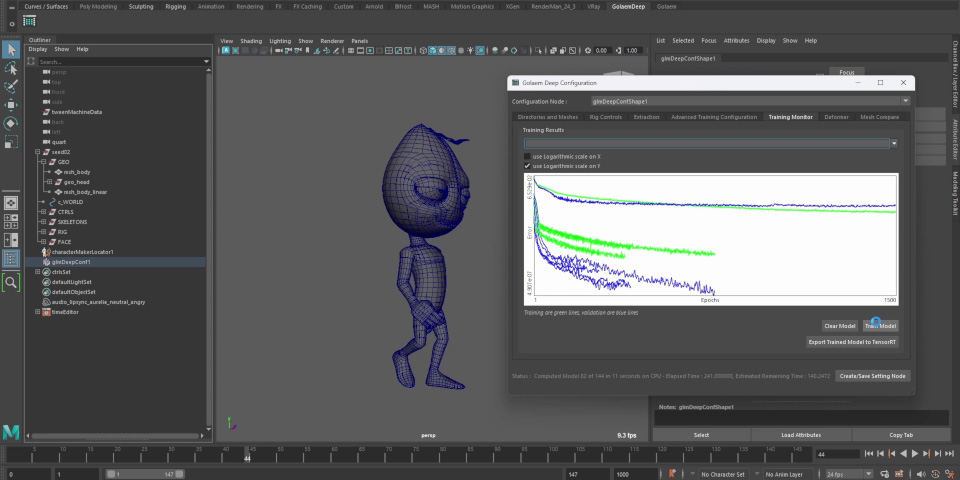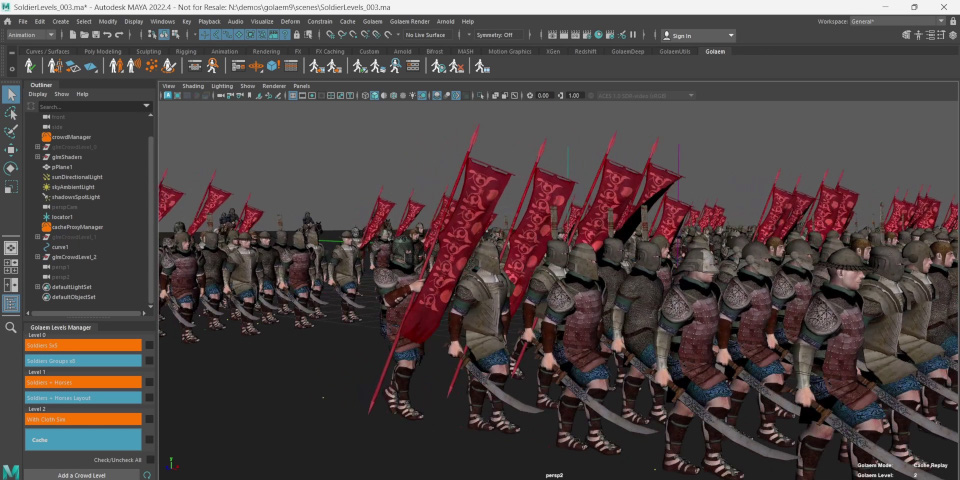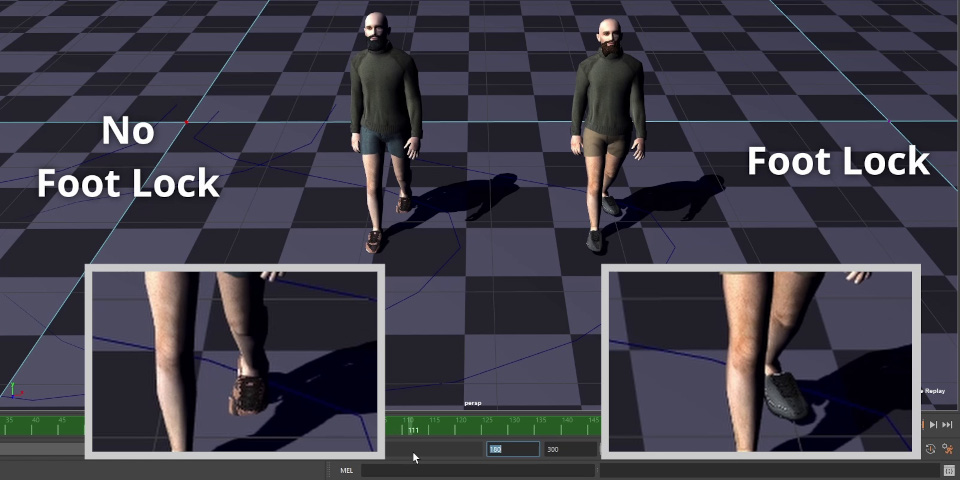Golaem releases crowd animation tool Golaem 9
Golaem has released Golaem 9, a major update to its crowd simulation system for Maya that overhauls the software’s animation engine.
New features include support for modular character rigs, direct playback of mocap data on crowd characters, and an experimental new Unreal Engine-style ML Deformer.
The release also introduces new workflows for creating crowd animations directly, without simulation, and updating existing simulations non-destructively.
The update actually came out earlier this year – the current release is Golaem 9.0.2 – but Golaem has only just announced it publicly.
An intuitive crowd animation tool making use of standard Maya workflows
Launched in 2011, Golaem was designed to provide an intuitive approach to crowd animation, with users able to use Maya’s native tools to control crowd behaviour.
It also includes toolsets for building custom AI logic, generating automatic variations of crowd characters, and interactively previewing and editing simulations.
Output is compatible with Arnold, Guerilla Render, Redshift, RenderMan and V-Ray; and users can output to other DCC tools for rendering, including 3ds Max, Houdini and UE5.
Recent movies and TV series on which Golaem was used include Aquaman and The Lost Kingdom, Teenage Mutant Ninja Turtles: Mutant Mayhem, and The Mandalorian.

A motion clip from the Mixamo online library being played back on crowd characters inside Golaem, thanks to the new animation engine’s support for direct mocap replays.
Golaem 9: new animation engine supports modular rigs and mocap replays
Golaem 9 updates the software’s animation engine, removing some of the previous constraints on the types of characters that can be used in crowd simulations.
In particular, Golaem now supports modular rigs directly, without relying on secondary skeleton mapping: something that Golaem claims is a first for a commercial crowd tool.
The new engine supports nine degrees of freedom (9-DoF), making it possible to control animation on three co-ordinate axes for translations, rotations and scaling.
It is also now possible to use motion-capture data directly as Motion Clips in Golaem Behaviors, enabling animators to play animations directly on crowd characters.
The software supports mocap data in FBX, BVH and USD (UsdSkel) format, retargeting it to the characters selected on the fly.

The ML Deformer system makes it possible to train a neural network to approximate the output of a high-quality character rig, then apply it to characters at render time.
Experimental new ML Deformer uses AI to add detail to crowd animations
The update also adds an experimental new ML Deformer, making it possible to use machine learning techniques to create higher-fidelity crowd animations.
Golaem describes it as being similar to Unreal Engine’s ML Deformer framework, making it possible to approximate the deformations generated by a high-performance character rig, and apply them to a character with a less complex rig at render time.
It comes with a training tool to encode any deformation done on a Maya rig, even deformation created using custom plugins.

Golaem 9’s Crowd Levels let artists update existing simulations non-destructively.
Create shots without simulation and update existing sims non-destructively
Golaem 9 also introduces important new workflows, including the option to create shots entirely without simulation, and to refine existing simulations non-destructively.
The new CreateEntity Layer makes it possible to build an entire shot with the Layout tool, with users creating characters directly at layout time, ready to be multiplied with the Duplicate or SnapTo layers, and animated with the PlayMotion layer.
Golaem tells us that the workflow is particuarly useful for choreographing street scenes, where large numbers of ambient characters are performing separate actions.
It can also be used to edit existing animations: for example, by adding extra characters to shots, or reanimating selected characters.
In addition, a new Crowd Levels paradigm lets users build shots incrementally.
Under the new workflow, artists can establish the overall motion of the crowd characters, then add extra passes for cloth simulation or secondary animation.
That should make is possible to edit the animation non-destructively, updating an existing simulation in response to feedback from clients or supervisors.
Other new features in Golaem 9
Other new features include a new TrackLocator node, which drives characters between two animatable curves, providing greater control over the overall shape of a crowd.
The LOD (Level of Detail) system has also been expanded, with LOD levels now able to contain different numbers of meshes, and meshes with different names.

Golaem’s new automatic foot locking mode, added in Golaem 8.2.4 last year.
Other features added since Golaem 8.0: includes automated foot-locking
Golaem’s blog post on Golaem 9 also includes a few features added later in the Golaem 8.x updates, including a new procedural foot locking system.
The new mode, available in the AdaptGround Behavior, is intended to reduce foot slippage in crowd character automatically, without the need to edit input motions.
It is also now possible to create custom display shapes for character proxies on a per-character basis, providing more control over how they look in previews.
The Channel Operators (ChOp) system, Golaem’s node-based system for creating custom crowd behaviors, gets new GeometryInput, Memory, Ramp and Counter nodes.
Price and system requirements
Golaem 9.0.2 is compatible with Maya 2020+
A perpetual license of the full software costs $9,000. Golaem Lite, the cut-down edition of the software for shot layout work, previously known as Golaem Layout, costs $2,300.
Rental costs $850/month or $5,000/year for Golaem itself, and $210/month or $1,250/year for Golaem Lite.
Read an overview of the new features in Golaem 9 on Golaem’s blog
See a full list of changes in Golaem in the online documentation
Have your say on this story by following CG Channel on Facebook, Instagram and X (formerly Twitter). As well as being able to comment on stories, followers of our social media accounts can see videos we don’t post on the site itself, including making-ofs for the latest VFX movies, animations, games cinematics and motion graphics projects.
